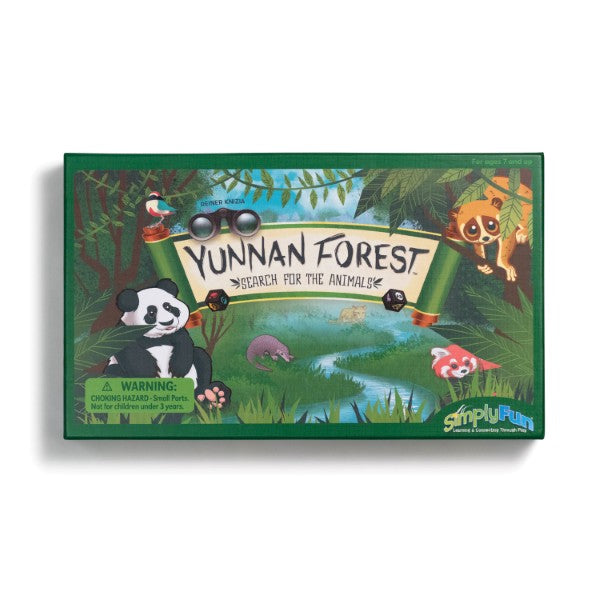
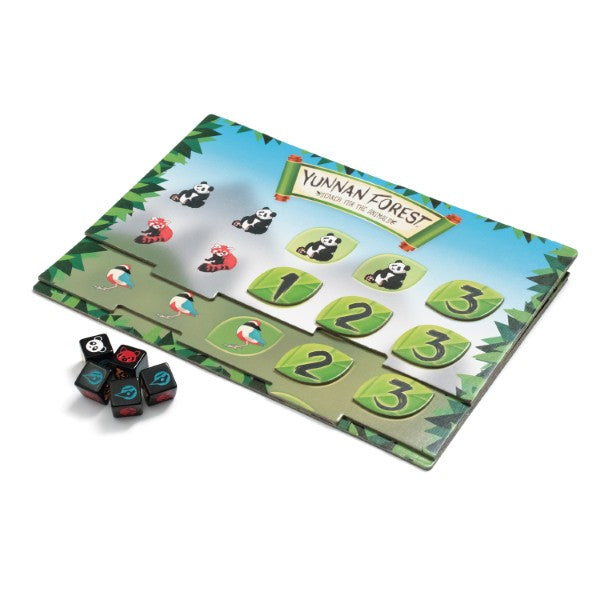
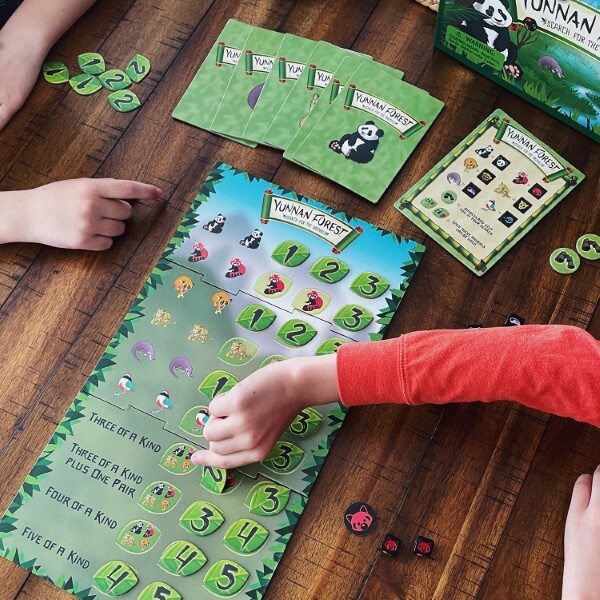
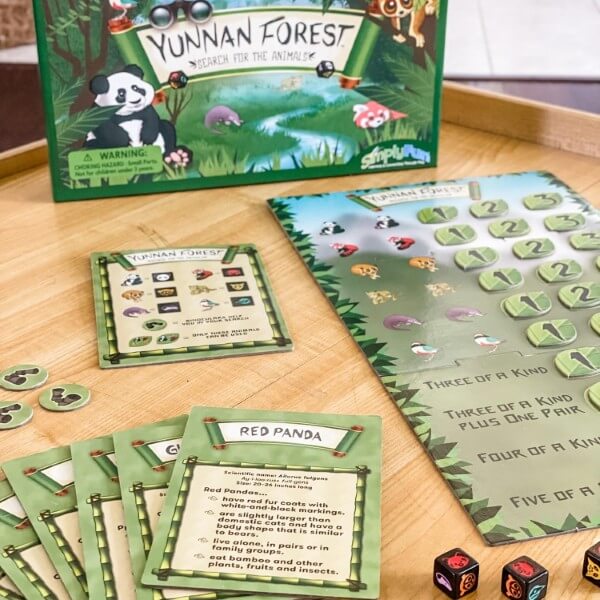
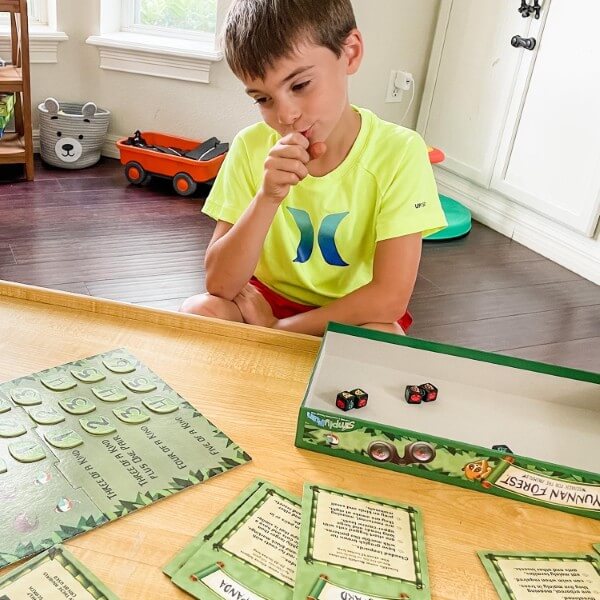
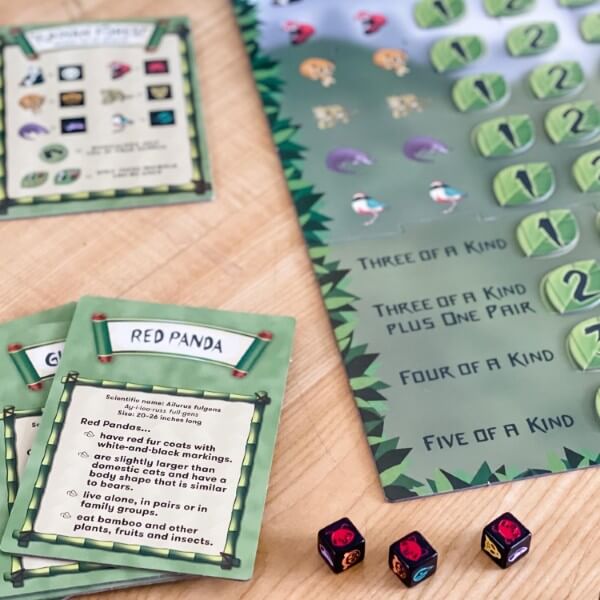
Collapsible content
Today, we’re going to search the forest for animals as we learn to play SimplyFun’s Yunnan Forest.
You can play Yunnan Forest with 2 to 4 players, ages 7 and up.
Yunnan Forest is great for developing strategy skills, as players match dice rolls to leaf tokens on the board while considering what tokens remain left in play.
Yunnan Forest also improves probability skills. Players choose which leaf tokens to aim for based on their chances of successfully making match.
To set up the gameboard, assemble the three puzzle pieces faceup in the center of the play area. Place the legend card and all six animal cards near the gameboard so they are available for players to look at.
Place the 5 dice near the game board within reach of all players. Next, place the leaf tokens in their appropriate locations.
Each of the top six rows have a specific animal, and have space for one each of the ‘1’, ‘2’, and ‘3’ leaf tokens. The bottom section of the gameboard is different; the first line, ‘Three of a Kind’, has the ‘1’, ‘2’, and ‘3’ leaf tokens like the rows before it. Next, the ‘Three of a Kind + One Pair’ row has a ‘2’, ‘3’, and ‘4’, the ‘Four of a Kind’ row has a ‘3’, ‘4’, and ‘5’, and the ‘Five of a Kind’ row has a ‘4’, ‘5’, and ‘6’.
Lastly, players should place the binoculars tokens animal-side down, mix them up, and place them next to the gameboard.
Players roll the dice to match up animals and earn leaf tokens. If you are unable to make a match, pick up a binoculars token that may help you later in the game. Play continues until after all the binoculars tokens have been claimed, and the player with the highest score from leaf tokens at the end of the game wins!
Each of the six animals are shown in rows at the top sections of the gameboard. Players will need to roll a pair of animals to earn the single-point leaf token. Removing that leaf token reveals the next animal, which means that rolling three of that animal is now required to collect the two-point leaf token. Once a player rolls four of that animal, they earn the final three-point leaf token, and that row is now closed.
Different types of matches are required for the bottom section of the gameboard. Players must roll three, four or five of the same animal, or roll three of one animal and a pair of another. As players fulfill these instructions and remove leaf tokens, the difficulty increases. Removing a leaf token reveals which animals can still be used when earning future leaf tokens.
To start the game, the starting player rolls all five dice. After your first roll, you may choose to reroll any or all the dice up to two more times, totaling a maximum of three dice rolls per turn.
If possible, match your dice roll to any of the leaf tokens found on the game board. If you make a match, take the corresponding leaf token and place it in front of you.
Only one leaf token can be earned each turn.
Each leaf token has a point value printed on it, and when added together at the end of the game they add up to the player’s final score.
Players must take the lowest-value leaf token available. As these leaves are removed from the gameboard, the dice combinations required to earn them becomes more difficult.
If you are unable to make a match on your turn, take a binoculars token. These binoculars will increase your chance of success on a later turn by acting as an extra animal alongside your dice roll.
At any point during one of your turns, you may choose to play your binoculars token that you have earned previously.
You may only play one binoculars token each turn, and each token may only be played once.
To play your token, you must share one new fact about the animal featured on your binoculars token from its corresponding animal card.
Once played, keep your binoculars token animal side up in front of you so that other players know which tokens have already been played.
Important Note: If it is possible for you to make a match on your turn, with or without a binoculars token, then you must do so.
After rolling the dice, choosing whether or not to play a binoculars token (if you have one), and possibly earning a leaf token, your turn is over and it is the next player’s turn.
Play continues until the last binoculars token is removed from the play area, even if there are leaf tokens left on the gameboard. Then, each player has one more turn, including the player who took the last pair of binoculars.
Once gameplay is over, the binoculars tokens have no point value and do not affect your score. The last turn before the game ends will be your last chance to use these tokens.
After all players take their last turn, each player adds up their points from leaf tokens earned during the game. The player with the highest total score wins!
In the case of a tie, the player with the highest number leaf token is the winner.
Get ready to use your dice and binoculars tokens to discover the animals in the Yunnan Forest.

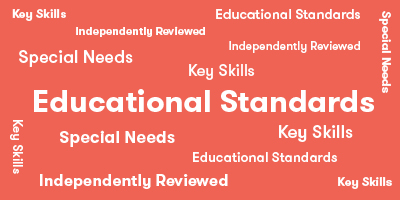
Core Standard*: Language, Math
Reading
- Reading: Informational Text
- Range of Reading and Level of Text Complexity. Grade Levels 3rd
- Reading: Foundation Skills
- Phonics and Word recognition. Grade Levels 2nd, 3rd
- Language
- Vocabulary Acquisition and Use. Grade Levels 2nd, 3rd
- Knowledge of Language. Grade Levels 2nd, 3rd
Math
- Operations and Algebraic Thinking
- Add and subtract within 20. Grade Levels 1st, 2nd
- Number & Operations in Base 10
- Understand place value. Grade Levels 1st, 2nd

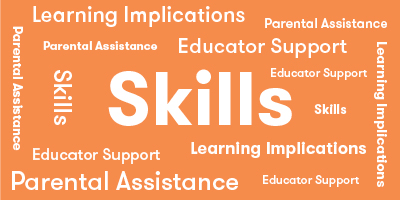
Explore
What Does Child Do To Use Skill In The Game?
Players need to examine the board and their dice closely in order to make the best scoring choice on their turn
How Parents Can Assist Learning
No special adult support is required.
If you notice that a child does not see all of the scoring options based on their roll, encourage the child to look again closely and let them know there is more than one option.
Learning Implications and Educator Support
Yunnan Forest is good for developing focus and self-control.
Children need to look closely at the board while they roll their dice in order to decide when to stop rolling, when to play a binocular token, and what leaf token to select.
Determine
What Does Child Do To Use Skill In The Game?
Players need to decide which dice to keep and which to roll again, and, if possible, which leaf token to select on their turn.
How Parents Can Assist Learning
No special adult support is required.
If you notice that a child does not see all of the scoring options based on their roll, encourage the child to look again closely and let them know there is more than one option.
Learning Implications and Educator Support
Yunnan Forest is good for developing focus and self-control.
Children need to look closely at the board while they roll their dice in order to decide when to stop rolling, when to play a binocular token, and what leaf token to select.
Compare
What Does Child Do To Use Skill In The Game?
Players compare the animals on their dice with the animals and scoring options on the game board.
How Parents Can Assist Learning
To help with impulsivity, encourage children to look closely at the game board on each roll. It can also be helpful if the child says the scoring options aloud so that you know that they are examining the game board accurately.
Learning Implications and Educator Support
Children learn to compare and match objects as well as matching the grouping of objects, such as three of a kind.
To help with impulsivity, encourage children to look closely at the game board on each roll. It can also be helpful if the child says the scoring options aloud so that you know that they are examining the game board accurately.
Remember
What Does Child Do To Use Skill In The Game?
Yunnan Forest is not a memory game. However, if players read the animal cards prior to the start of the game, they may share animal facts from memory rather than reading the animal card during game play.
How Parents Can Assist Learning
Parents can have the child read an animal card. Then, ask questions based on the facts from the card to see if the child remembers. For example, "What is the smallest Slow Loris?" Answer is "Pygmy Slow Loris."
Learning Implications and Educator Support
To help build memory skills, educators can have children read the animal cards. Then, ask questions based on the facts from the card to see if the child remembers.
Predict
What Does Child Do To Use Skill In The Game?
There is some predicting involved playing Yunnan Forest as players consider which dice to keep and which to reroll based on the probability that desired animal icons will be appear on subsequent rolls.
How Parents Can Assist Learning
Parents can prompt children to practice predicting by asking them to say which animals they hope will appear on the next roll.
Learning Implications and Educator Support
Educators can prompt children to practice predicting by asking them to say which animals they hope will appear on the next roll.
Demonstrate
What Does Child Do To Use Skill In The Game?
While not explicitly required, players likely will show how their dice match the grouping required to take a leaf token.
How Parents Can Assist Learning
No special adult support is required.
Learning Implications and Educator Support
No special adult support is required.
*Data compiled from CCSSI ELA Standards, WA Science Standards, and Washington Social Studies Standards

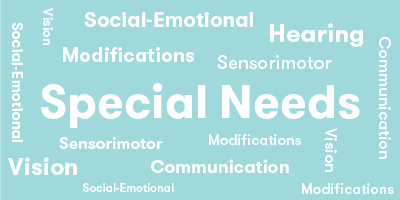
Cognitive
Suggestions for How to Modify Play Experience
Children with cognitive delays may be confused by having to throw two- of-a-kind to take a leaf with a '1,' three-of-a-kind to take a two, etc.. Change the rules so one-of-a kind, takes 1 leaf; 2-of-a-kind takes a '2' leaf;' three-of-a kind takes a '3' leaf. This encourages use of one-to-one correspondence that is important for learning to count with accuracy.
To make the game easier, omit the bottom section of the board with the more advanced combinations such as 3 of a kind and a pair. As children master the first two board sections, add the last board and play the first row. Then, include the second and third rows as children become more proficient. Use a piece of paper to cover up the unused rows.
Remove the binoculars from the game if they are confusing to the player. It may be difficult for them to comprehend that the tile can act as another die. Deciding when to use the binoculars to greatest advantage is also difficult for children with limited problem solving ability.
Communication
Suggestions for How to Modify Play Experience
When a player uses a binocular token, they need to read a fact from the Animal Card about the animal on the token. If children have difficulty reading, they can point to a fact on their card and have another player read it.
If players have difficulty communicating, they can group the dice to indicate which combination of animals they are using to make a move.
Sensorimotor
Suggestions for How to Modify Play Experience
Use a cup for rolling if players have difficulty handling multiple dice.
The leaves and binocular pieces are fairly thick, so unless children have difficulty picking up something the thickness of two quarters, they should be able to play. If this is a problem, the player can point to have another player remove the leaves.
If all players do not use sign language, the player who is deaf can point to a fact on the animal cards for another player to read.
Social Emotional/Behavioral
Suggestions for How to Modify Play Experience
Play in pairs to allow joint decision making. This will reduce stress, impulsive thinking, and limit frustration.
Vision
Suggestions for How to Modify Play Experience
Yunnan Forest is not recommended for vision impaired, particularly with color blindness, unless players can match the colors on the dice to the colors on the animals on the board.
Hearing
Suggestions for How to Modify Play Experience
Players may not be able to hear the facts being read, but they may read the facts after they are read.
*Data compiled from CCSSI ELA Standards, WA Science Standards, and Washington Social Studies Standards

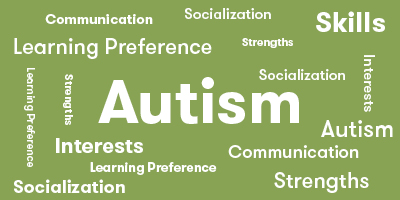
Autism Strengths & Interests
Short Summary of Strengths & Interests
- Strategic thinking
- Probability
- Sequencing
Is good at matching visual items
Is This Game Appropriate? Yes
Description
Players have to match the animals on the dice to create pattern of dice that match what is needed on the board (animals and number of dice) to take a leaf.
Has a good memory for sensory details, including visual, touch, taste and smell
This game is not appropriate
Has a good memory for words, phrases and dialouge
This game is not appropriate
Has a good memory for pictures, numbers and patterns
Is This Game Appropriate? Yes
Description
Players need to remember how many points they are accumulating and also pay attention to the points others are gaining.
Likes to put things in order or a sequence
Is This Game Appropriate? Yes
Description
Players earn leaves in a sequence that requires tossing dice in increasingly large numbers of the same animal. Players need to be able to see what leaves have been taken off the board and know what animals and number of dice is needed next.
Learns through visualizing or "replaying" actions in their mind
Is This Game Appropriate? Yes
Description
Players may be able to use the ability to recall previous dice throws and decisions to inform their current and future turns.
Likes activities with rules, such as math and phonics
Is This Game Appropriate? Yes
Description
Simple addition is needed at the end of the game to determine the winner.
Is very concrete and literal
Is This Game Appropriate? Yes
Description
The game using dice and concrete leaf tokens to make moves and mark what has been earned, but players also need to do strategic thinking to make good decisions about each round of play.
Learns in small "chunks" (for example, phone numbers are 3 chunks of number xxx-xxx-xxxx that are combined together)
This game is not appropriate
Is good at nonverbal reasoning and logic
Is This Game Appropriate? Yes
Description
The key to winning Yunnan Forest is to be able to select which leaf tokens to target for collecting. By thinking about what is available on the board and which tokens are worth the most points, players can decide what dice to keep and which to rethrow to get the desired result.
Likes spatial problem solving
This game is not appropriate
Can read well with good vocabulary, though may not fully comprehend content
Is This Game Appropriate? Yes
Description
In order to play a binocular token, a player needs to first share a fact from the Animal Card that matches the picture on the token. This involves reading one of the facts on the card to the other players.
Likes to use and has good fine motor skill
Is This Game Appropriate? Yes
Description
Limited fine motor skills are involved. Players throw five dice, arrange them in matching patterns, and take tokens from the board.
Likes established routines or set ways of doing things
This game is not appropriate
Likes manipulating, constructing or building things
This game is not appropriate
Likes to use and has good musical abilities
This game is not appropriate
Likes to use and has good drawing skills
This game is not appropriate
Autism Special Considerations
Appears to ignore other's communication and/or has difficulty giving eye contact to a communication partner
Is This Game Appropriate for Child with Characteristic? Yes
Can Child with Characteristic Play Game w/o Modification? Yes
Strategies for Developing Compensatory Skills:
Players do not need to give direct eye contact to play Yunnan Forest. They can focus on the dice and the board.
Has difficulty understanding complex verbal directions
Is This Game Appropriate for Child with Characteristic? Yes
Can Child with Characteristic Play Game w/o Modification? No
Strategies for Developing Compensatory Skills:
Uses vocabulary inaccurately or demonstrates echolalia (repeating another's speech)
Is This Game Appropriate for Child with Characteristic? Yes
Can Child with Characteristic Play Game w/o Modification? No
Strategies for Developing Compensatory Skills:
Encourage players to comment on what they are doing as they make a play. That may help some children repeat things that are relevant to the game.
Gets stuck repeating a verbal topic or physical actions and/or has difficulty attending to others' actions or topic.
Is This Game Appropriate for Child with Characteristic? Yes
Can Child with Characteristic Play Game w/o Modification? Yes
Strategies for Developing Compensatory Skills:
Players can play without attending to others' turns, as long as they can focus on the board and their options when play comes back to them.
Has difficulty producing speech/communication
Is This Game Appropriate for Child with Characteristic? Yes
Can Child with Characteristic Play Game w/o Modification? Yes
Strategies for Developing Compensatory Skills:
Communication among players is not needed, but should be encouraged.
Has difficulty sequencing multi-step actions and/or doing complex abstract tasks
Is This Game Appropriate for Child with Characteristic? Yes
Can Child with Characteristic Play Game w/o Modification? No
Strategies for Developing Compensatory Skills:
There are multiple steps in a turn, including potentially multiple throws of the dice, arrangement of dice, and selection of a match on the board, and removal of a leaf. In addition, players have the option of using a binocular token to supplement the dice. This sequence may be too difficult for some children. Playing as a partner is one option that may help the child learn the game.
Demonstrates difficulty initiating and maintaining social interactions
Is This Game Appropriate for Child with Characteristic? Yes
Can Child with Characteristic Play Game w/o Modification? Yes
Strategies for Developing Compensatory Skills:
Social interactions are not needed, but should be encouraged.
Acts out or demonstrates avoidance behaviors when frustrated, overwhelmed, or needs more sensory input.
Is This Game Appropriate for Child with Characteristic? Yes
Can Child with Characteristic Play Game w/o Modification? No
Strategies for Developing Compensatory Skills:
The game has complicated instructions. Modify the game to simplify it by removing the binocular tokens and eliminating the bottom game board section.
Has short attention span for non-preferred activities
Is This Game Appropriate for Child with Characteristic? No
Can Child with Characteristic Play Game w/o Modification? No
Strategies for Developing Compensatory Skills:
Unless the child likes animals or dice games, Yunnan Forest may not be a good choice.
Needs sameness or consistent routines and/or has difficulty with transitions from one activity to another
Is This Game Appropriate for Child with Characteristic? No
Can Child with Characteristic Play Game w/o Modification? No
Strategies for Developing Compensatory Skills:
Has difficulty understanding others' feelings, intentions, and the reasons for others' actions.
Is This Game Appropriate for Child with Characteristic? Yes
Can Child with Characteristic Play Game w/o Modification? Yes
Strategies for Developing Compensatory Skills:
Players do not need to understand others' thoughts or feelings. It is helpful for children to watch the numbers on the leaves other players take in order to keep track who is ahead, and what numbers the child needs to acquire to catch up and win.
*Data compiled from CCSSI ELA Standards, WA Science Standards, and Washington Social Studies Standards

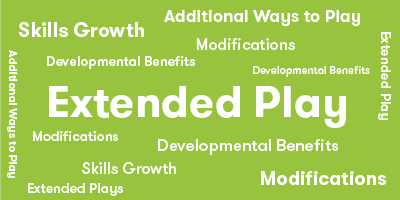
Extra Ways to Play the Game
Use the dice without the board. Play "poker" with the dice based on matching and sequencing the animals. Each person rolls in turn. The person with the highest roll wins the round and earns a leaf.
Play one roll on the first round, two possible rolls on the second round, and three possible rolls on the third round. This sequence is repeated for 9 rounds. Whoever has the most leaves wins the game.
Optionally, each player can take a binocular token at the beginning of the game. The animal on the other side can be used once during the game to replace one of the 5 dice the player has rolled.
Similar to poker, the winning sequence is as follows: One pair, two pair, three of a kind, three of a kind and a pair, four of a kind, five different animals, and five of a kind.
Materials Needed
No additional materials are needed.
Developmental Benefits
This modification of Yunnan Forest has a higher level of risk and reward. On multiple turn rolls, players decide whether to stand with a roll or roll again to try for a better result. Players also have only one '"wild" token, so they need to decide when to use it. This requires players to resist impulsive responses, compare what other players have rolled, and anticipate when the token might be more useful.
Extra Ways to Play the Game
If an internet enabled device is available, sit with your child and search the internet for videos of and information about the animals in the game and other animals in the Yunnan Forest.
Materials Needed
Internet enabled device and access to the internet.
Developmental Benefits
Yunnan Forest introduces many animals that may be unfamiliar to the children and even adults. Encourage the development of curiosity and discovery by working with children to seek out more information about the Yunnan Forest and other animals that are found there.
*Data compiled from CCSSI ELA Standards, WA Science Standards, and Washington Social Studies Standards
Game Details
- 1 Gameboard (3 puzzle pieces)
- 6 Animal Cards
- 1 Legend Card
- 30 Leaf Tokens
- 5 Animal Dice
- 6 Binoculars Tokens
- 1 Rules Booklet
- Choosing a selection results in a full page refresh.
- Opens in a new window.







